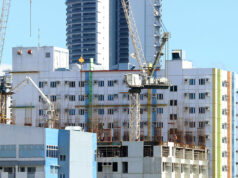In Camiguin, ‘LS-A’ of the new D-MAX means ‘Lanzones Safely Arrives’
Text and photos by Aries B. Espinosa
ITS SCIENTIFIC NAME is Lansium domesticum. In English and in the vernacular, it’s called lanzones or lansones. In Thailand, it’s called longkong. In Japan, its equivalent is the much more expensive biwa (How expensive? Try P2,500 per kilo).
However which way it’s called, the sweetness and texture is what makes us want more. That was what was swirling in the minds of the nearly 30 participants to Isuzu Philippines Corporation’s (IPC) Media Ride-and-Drive Experience of Camiguin Island on board the new D-MAX LS-A, Isuzu’s latest and most modern iteration of its iconic pickup line.
The days were sunny, interspersed with cotton-candy clouds, and the evenings and mornings were freshened up with light rain during the two days we spent in Camiguin Island on Oct. 10 and 11 — just the ideal weather to test the power, comfort, and ride handling of the new D-MAX pickups on the ruggedly picturesque island-province situated just north of Misamis Oriental, accessible by direct flights from Manila or via a 45-minute RoRo (roll on, roll off) from Balingoan Port, a two-hour shuttle ride from Cagayan de Oro City.
The pickup beds of the D-MAX turned out to be handy, as it was peak harvest season for the delectable lanzones (The week-long Lanzones Festival happens on Oct. 21 to 27), and the kind, forward-thinking Governor Jurdin Jesus M. Romualdo made sure that each of us went home heavy with the fruit.
The island, of course, is about much more than its most famous produce. Despite having a mere land area of just 238 square kilometers (making it the Philippines’ second smallest province after Batanes), Camiguin is home to four stratovolcanoes, the most famous of which is Mount Hibok-Hibok. Past eruptions of these volcanoes resulted in many of the natural and man-made tourist draws, such as the Tres Marias domes, the blue lagoon, the Sunken Cemetery and the Bonbon Church Ruins.
It’s the island’s fiery origins and mountainous terrain that also drew in IPC over 16 years ago to test-drive the D-MAX’s immediate predecessor, the Isuzu Fuego. The model name, which literally translates to “fire”, experienced the short but rugged roads that circled the island — the same roads that the 2020 D-MAX LS-A pickups were now traversing.
The times may have differed 16 years apart, but the experience of the island haven’t been that different. The only big difference was the ride we were in.
The New D-MAX LS-A set out to prove it was “tough enough for anything,” and barring any volcanic eruptions during our stay, the pickups did show it could take on what one of the most rugged island-provinces of the Philippines could bring, and still treat the driver and occupants like royalty.
The New D-MAX LS-A is powered by the powerful and fuel-efficient 4JJ1-TCX 3.0-liter 4-cylinder In-line Blue Power Diesel engine with VGS turbo intercooler that generates 177 PS @ 3,600rpm and maximum torque of 380Nm @ 1,800-2,800rpm. Available in the 4×2 and 4×4 MT and AT variants, the D-MAX LS-A drivetrain consists of either the 6-speed automatic transmission with sequential shift or the 6-speed manual transmission with gear shift indicator.
Comfortable, stable and confident handling was achieved with the rack-and-pinion power assist and tilt adjust steering, independent double wishbone with coil spring and stabilizer for the front suspension, and semi-elliptical leaf spring for the rear.
For its exterior, the New D-MAX LS-A is distinctive with the aggressive-looking very dark gray radiator grille with engine hood garnish, front bumper guard and one step type black rear bumper, power folding side view mirrors in dark gray finish with LED integrated turn signal, and LED rear combination lamp. The under-rail bedliner, cargo extender, roof rail, fender lip-type over fender, and side molding all come standard.
The stylish and functional character of the New D-MAX LS-A continues in the interior’s electroluminescent-type instrument meters with Multi-Information Display (MID), 8-inch full-touch monitor/CD/DVD/Tuner/Bluetooth and iPod connectivity/Aux-in/USB/MP3 Compatible/AV-in/TPMS ready/USB-link/WiFi display, navigation system, and three-spoke leather-wrapped steering wheel with hands-free function and audio controls. The bucket seats with adjustable headrest, back pockets and convenience hook (1st row) and the 60/40 split cushion 2nd row seats with two adjustable headrests and center arm rest are all wrapped in leather.
The New D-MAX LS-A is equipped with numerous safety features: Dual SRS air bags, child seat tethers for the 2nd row, side door impact beams, Anti-lock Brake System (ABS), Electronic Brake Force Distribution (EBD), Brake Assist (BA), Brake Override System (BOS), Hill Start Assist (HSA), Hill Descent Control (HDC), Child-proof rear door locks and reverse camera.
For occupant comfort and convenience, the New D-MAX LS-A is equipped with the auto-climate control air-conditioning system, passive entry/push start-stop system, 12V accessory socket, three USB charging ports, 15 storage compartments and 10 cup holders, and tow hooks for the front-driver and passenger side and one at the rear (for the LS-A 4×4 variants).
IPC President Hajime Koso, in his welcome remarks to the participants, shared that this was his first time to visit Camiguin, and he saw the rugged beauty and progressive eco-tourism programs of the island as “a perfect fit” for the New D-MAX LS-A.
“The Isuzu D-MAX LS-A with Blue Power Diesel engine is our answer to the clamor of our customers for reliable, hardworking but fuel-efficient vehicles. This represents nearly a century of Isuzu’s experience and innovation in the design, engineering, and workmanship of diesel-powered utility vehicles. The D-MAX LS-A is infused, as well, with features that address the demands of a market that value both hard work and play, business with leisure.”
On board the 4×2 and 4×4 variants of the New D-MAX LS-A, our group convoyed to the island’s top attractions: The Taguines Lagoon; the island’s interior featuring the towering and still active stratovolcano Mount Hibok-Hibok and Tres Marias lava domes; refreshing Tuasan Falls; Lanzones Farm; the Bonbon Church ruins and the Sunken Cemetery, where the remnants of a graveyard and a town destroyed and sunk into the sea by the explosive birth of nearby Mt. Vulcan in the 1870s provided the solemn foreground to a magnificent sunset.
The second day of the trip saw the group spend the morning on the powder white sandbar, a mere 15-minute speedboat ride on the clear blue Bohol Sea.
IPC’s return engagement with fiery Camiguin and its cheerful people was a fun event powered by the New D-MAX LS-A pickups. More importantly, the New D-MAX LS-A makes it possible to extend the fun driving and riding to what we do outside the cabins.
To know more about the New D-MAX LS-A and IPC’s full roster of vehicles, log on to www.isuzuphil.com.



